Nepomniachtchi defeats Ding in the second game of the World Championship match
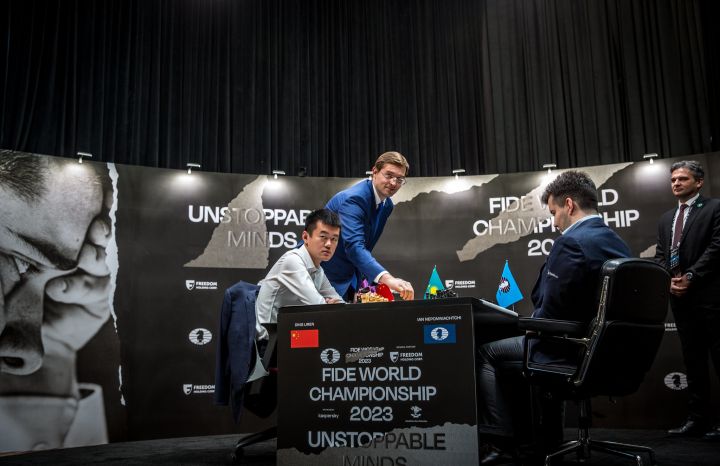
Ian Nepomniachtchi seized an early advantage in the race to be crowned the 17th World Chess Champion after beating Ding Liren withblack pieces in the second game of the match in Astana In the second game of the match to determine the 17th WorldChampion in chess, Ian Nepomniachtchi defeated Ding Liren with black pieces in a game that lasted just 29 moves and three and a half hours. Ding Liren surprised his opponent early in the opening, throwing Nepomniachtchi off his theoretical preparation. Despite the element of surprise, a slight edge in the position and a more significant one on the clock, Ding Liren did not find the best way forward in the middlegame and allowed Black to take the initiative and dominate on the board. Ding had to sacrifice a bishop and two pawns for a rook to ease off some pressure, but that wasn’t enough to save the game. Nepomniachtchi was confidently building up the pressure. Ding also ended in desperate time trouble – with just three minutes to make 15 moves to reach the first time control. White struggled but ultimately had to resign. A serious blow to Ding in his first game as White and a very important victory for Nepomniachtchi with black pieces, giving him an early advantage in the match. Tomorrow is the first rest day, with the third game of the match set to take place on Wednesday, 12th April at 3 PM local time in Astana. Here follows a closer look at the second game of the match. In this game, Ding Liren was White while Ian Nepomniachtchi was playing as Black. The honour of the first ceremonial move in the second game of the match went to Timur Turlov, the Founder and CEO of Freedom Holding Corporation, the General Partner of the FIDE World Championship. Ding started with 1.d4 and after standard moves 1..Nf6 2.c4 e6 3.Nf3 d5 the Chinese GM played 4.h3!? stood up and walked away from the board. A surprising choice, going immediately for the sideline in the Queen’s Gambit. This was played in a blitz game between Ding and Levon Aronian in the 2021 Speed Chess Championships. The goal was to get Nepomniachtchi out of his preparation. Grandmaster Irina Krush immediately noted that this move was a sign of Richard Rapport’s influence on Ding. Vishy Anand noticed that when Nepomniachtchi saw this move, he smiled. In the post-game interview, Nepomniachtchi was also asked to comment on the move 4.h3, which was a surprise. “I thought it was a move influenced by Richard [Rapport, who is Ding’s second in the match]… I’m not sure if this move is good or bad. The move clearly has its own idea, and it worked.” Ding Liren also commented on this move: “This is a rare move, and it was a good idea of my seconds. I know a lot of ideas after 4.h3, but today’s game was a disaster.” Anish Giri noted that 4.h3 means that Ding is happy to accept a slightly inferior move in the opening, but none of them are openings that Ian feels at home in. After about eight minutes of thinking, Nepo decided to play the principle move and take on c4, going into the Queen’s gambit accepted where h2-h3 might not be a useful move for White. After a series of natural moves, the opponents reached the position that became the first big crossroad for Ding. The Chinese GM had to decide between taking on c5 and f6. He spent a lot of time thinking about the move in his lounge. After a 33-minute-long reflection, Ding walked back to the board and made his move. 12.Nxf6+ This choice will ultimately prove to be the start of Ding’s downfall, whereas after 12.Nxc5 Bxc5 13.dxc5 Nd7 White is slightly better. Also, by this point, the advantage he had on the clock over Black evaporated. Instead of taking with the queen, Nepo opted for a much more aggressive 12…gxf6, manifesting his intention to castle long and use the open g-file for an attack on White’s king. Apparently, this turn of events came as an unpleasant surprise for Ding as just five moves down the road, he made a mistake. 17.Bd3? this move turned out to be wasting a tempo as after 17… Kb8 Black emerged clearly better. Black’s queenside is advanced and protected enough, he has aligned his rooks for an attack, and his structure is overall stable. White, on the other hand, is struggling, with his pieces hitting the pawn wall on the fourth rank. The best option for White was to stick to his initial plan and play Qe1, to x-ray the Black’s b4-pawn and support the white pawn on e4, and then play Kh1. Instead… 18.Re1? f5! Played quickly by Ian. Black has a strong advantage now: White’s centre is collapsing, his king is pinned, and Black’s advantage on the queenside is dominant. The point is that that 19.exf5 fails to 19…Rxd4! 20.Nxd4 Rxg2+ 21.Kf1 Rxf2+! and checkmate in two. 19.Bc2 was played after 20 minutes of thinking, but White already had no way out. To make things even worse for Ding, he had just 20 minutes against Ian’s 50. In the subsequent play, Black increased his domination in the centre by sacrificing an exchange and getting an overwhelming position. Black has two pawns for the exchange and a pair of powerful bishops. White is doomed, as Black’s c-passer will cost him a rook. The rest was a smooth sail for Nepo. 25.Rd2 Bd6 26.Kh1 c3 27.bxc3 bxc3 28.Rd4 c2 29.Qh6 e5 and with only a few seconds left on the clock, White resigned. Ding Liren had this comment about the game: “To lose like this… I cannot understand what’s happening. After 18…f5 the position is very difficult for me. I missed nearly everything in the game.” In the post-interview, Ian Nepomniachtchi confirmed that after 18…f5 he felt that he was winning. Asked about why he was spending so much time in the rest room, Ding said that it reminds him more of playing online and it makes him more comfortable.
Bernardo Roselli wins 2023 Uruguayan Championship
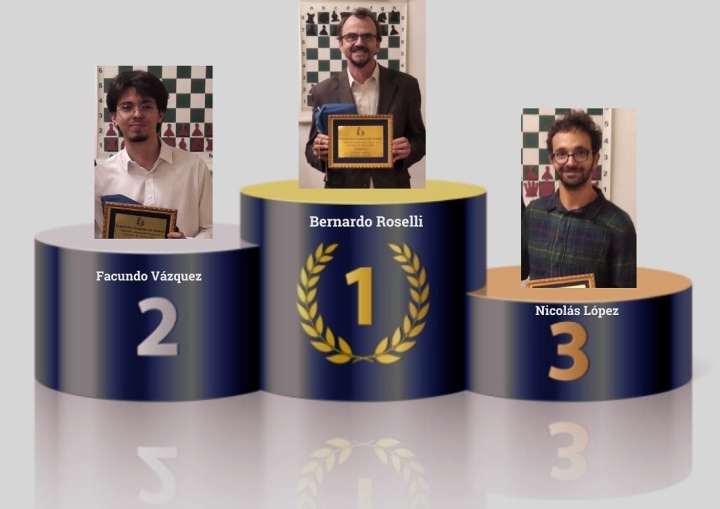
IM Bernardo Roselli emerged as the winner of the 94th Uruguayan Chess Championship. The 12-player round robin took place in the city of Montevideo in the first decade of April. The champion scored 8½ points out of 11 and reached the record mark of 21 national titles in 40 years of competition. Bernardo won his first crown back in 1984 at the age of 19 and now holds the double record of being the youngest and the oldest champion of Uruguay. As the national champion, Roselli qualified for the Uruguayan team to represent the country in the next World Chess Olympiad in Hungary in 2024. 19-year-old FM Facundo Vazquez Furtado finished second just a half-point behind Roselli and became the vice-champion for the third time in a row. Undoubtedly, Facundo instilled a fresh spirit in Uruguayan chess and sent a great message to other young players: dedication, determination and commitment can work miracles. FM Nicolas Lopez Azambuja netted 7½/11 and took bronze. The runner-up and the bronze winner completed the event undefeated. The event was broadcast on chess.com, live.followchess.com, lichess.org and playchess.com. Final standings: 1 IM Roselli Mailhe, Bernardo 2376 8½ 2 FM Vazquez, Facundo 2357 8 3 FM Lopez Azambuja, Nicolas 2225 7½ 4 GM Hoffman, Alejandro 2359 7 5 FM Carbone, Diego 2336 6½ 6 CM Carvalho, Guillermo 2101 5½ 7 IM Coppola, Claudio 2296 5 8 Elena, Eduardo 1915 4½ 9 FM Curi, Gabriel 2113 4½ 10 Ressia, Lorenzo 1928 3½ 11 FM Granara Barreto, Sebastian 2146 3 12 NM Saralegui, Mario 1992 2½ Text: Edgardo Campora Photos: Federación Uruguaya De Ajedrez Facebook
Vahap Sanal wins Fagernes International
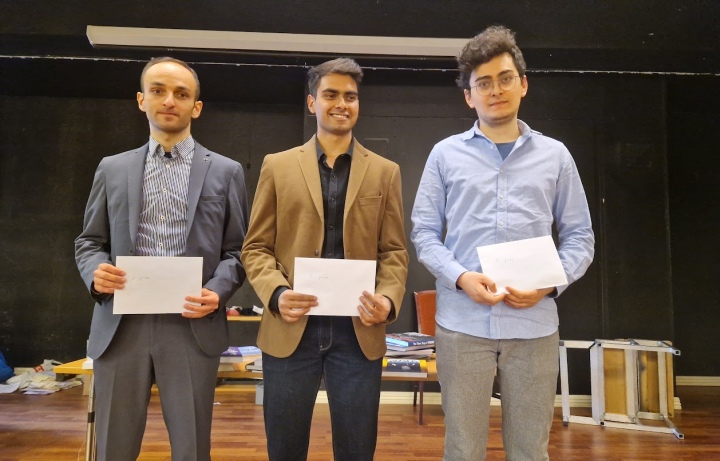
GM Vahap Sanal of Turkey came out on top in the Fagernes International GM tournament (Norway). A small town of about 2000 inhabitants located 185 km from Oslo, Fagerness hosted a traditional tournament held in two sections: GM and Open. The event, supported by the FIDE Aid Package, took place in the Scandic Valdres Hotel from April 2-9. The 2023 edition of GM tournament is included in the new FIDE Circuit. All games in both the GM Group and the Open Group, 9-round Swiss tournaments with classical time control, were played together in a big venue in the basement of the hotel. Coffee and ice water were available free of charge outside the playing venue during the playing sessions. The GM tournament was a close race of several top seed participants, with GM Abhimanyu Puranik of India coming into the final round half a point ahead of GM Vahap Sanal. The highest-rated GM Samvel The-Sahakyan (Armenia), Eduardas Rozentalis (Lithuania) another Indian, IM Adittya Mittal, trailed the leader by a full point. In the final round, Puranik made a quick draw with Rozentalis, whereas Sanal scored a crucial victory over Mittal. As a result, both Sanal and Puranik finished on 7½ /9 rounds, with the former taking first place thanks to better rating performance (first tiebreaker). GM Samvel Ter-Sahakyan of Armenia was third with 7 points, half a point ahead of GM Eduardas Rozentalis and GM S.P. Sethuraman (India) on 6½. Rozentalis took both the veteran prizes, for the highest number of points and rating performance. Final standings Fagernes GM: 1 GM Vahap Sanal 2582 7½ 2 GM Abhimanyu Puranik 2599 7½ 3 GM Samvel Ter-Sahakyan 2613 7 4 GM Eduardas Rozentalis 2504 6½ 5 GM S.P. Sethuraman 2639 6½ 6 IM Tor Fredrik Kaasen 2462 6 7 IM Chatterjee Koustav 2520 6 8 IM Mittal Aditya 2505 6 9 IM Elham Abdrlauf 2519 6 10 FM Benny Aizenberg 2366 6 The best woman prize goes to GM Monica Socko of Poland, ahead of the two Indians, WGM Vantika Agrawal and WIM Savitha Shri Baskar (pictured below). Agrawal, in addition, got the prize for the highest rating performance among the women. The Open was won by Sondre Stai of Norway with 7 points. Rune Kleiven Rynning of Norway on 6½ took second place, while Tim R. Spanton of England was third with the best tiebreak of several players on 6 points. Spanton was best veteran (60+) and Ida Lahlum (sister of the organizer) was the best woman. Photo: Tom Eriksen Official website: fagerneschess2023.blogspot.com/
FIDE World Championship match: The first game ends in a draw
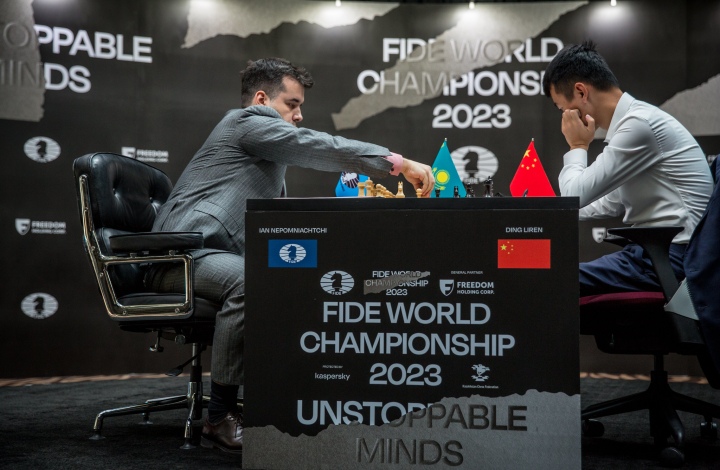
Despite getting an advantage with white pieces, Ian Nepomniachtchi could not find a way to convert it into victory as the Chinese Grandmaster Ding Liren defended well The opening game of the match to determine the 17th World Champion in chess ended in a draw after 49 moves and nearly five hours of play. The ceremonial first move in the first game of the championship was made by the Minister of Culture and Sports of Kazakhstan, Askhat Oralov, and FIDE President, Arkady Dvorkovich. In a sideline of the Ruy Lopez opening, Ian Nepomniachtchi surprised his opponent and seized the initiative as White. The Chinese player spent significantly more time in the opening and was struggling as White had an edge both on the board and on the clock. Nepomniachtchi missed a crucial opportunity to build up his advantage during the critical moments of the game, just before the first time control at move 40, where both players would get an extra hour. Despite his opponent having only a few minutes left on his clock, Nepomniachtchi did not manage to make the most of his opportunities and chose a plan that ultimately proved to be ineffective. As a result, Ian lost his edge on the board. As the players reached move 40 and the first time control, the position was even. Following White’s 49th move, in an equal endgame, Nepomniachtchi and Ding decided to split a point. During the press conference after the game, Ding Liren revealed that he felt “a bit depressed” before the game, suggesting that he felt he was “under too much pressure” to handle the match. Ding also revealed that he decided to move from the hotel where he was staying and the match is taking place. “Now I’m in the hotel I am more familiar with”, Ding said. The Chinese player also confirmed that he “didn’t prepare anything because he was struggling with his feelings and emotions”. Asked about his assessment of the game, Ding said: “It turned out that the opening phase I played well and was slightly better”. During the day it also transpired that GM Richard Rapport is in Astana as Ding’s second. When asked about this, Ding said: “I like his creative playing style. Also, I can speak English with him and he can help me come across better and improve my speaking. We also have many things in common – we like the music of the 1980s.” Ian Nepomniachtchi was not happy about the way he proceeded after the opening but was overall satisfied with his performance in the first game. The second game of the World Chess Championship match will take place on Monday, 10th April, at 3 PM local time in Astana. Here follows a closer look at the first game of the match in Astana. Playing with the white pieces Ian Nepomniachtchi opened with 1.e4. Ding Liren is known for playing a wide array of openings, but in this case, he responded with the predictable and solid 1…e5, and the opponents went for the Ruy Lopez. The first interesting moment came on move six when Nepomniachtchi surprised Ding with the Deferred exchange variation – 6.Bxc6. This is a known move, but Nepomniachtchi has not played it before. As Vishy Anand noted, this move was once considered as a way to avoid theory, but in the meantime, it may have also become theoretical. 6…dxc6 7.Re1 “A sideline within a sideline” as noted by GM Anish Giri. This move was not played at the highest level. This is the first moment where Ding paused to think longer. After following a beaten track for a while Ding introduced a novelty 11…Bg4, developing the c8-bishop, which is hardly better than popular 11…Ne6. Nepo wisely avoided an exchange by 12.Nd4, and both players started concentrating their pieces in the centre and soon reached the second important position. Ian just played 14.Nf5. At first glance, taking on f5 seems dangerous for Black. For example, 14…Bxf5 15.exf5 Re8 16.f6, but in reality, it was the shortest way to equality. Indeed, after 16…Bf8 17.Qg3 g6 18.Bxc7 Qd2! Black has sufficient counterplay. Ding opted for 14…Ne6, but after 15.Nxe7 Qxe7 White got a long-lasting initiative which Ian had a chance to build up several moves down the road. Here an immediate 21.f4 looks quite promising, but Ian preferred a more reserved 21.a3 and continued with slow maneuvering. This approach also worked for Nepo as having just 20 minutes on the clock, Ding made a serious inaccuracy weakening his pawn formation on the queenside and found himself in quite an unpleasant position. With 27.Qf4 White built a dangerous battery along the h2-b8 diagonal. “An Ian move”, as described by GM Anish Giri, who noted that such threats with queen infiltrations are a favourite move for Nepomniachtchi played when he feels comfortable and senses his chances. White’s advantage is becoming tangible now. 27…b5 was played by Ding, hoping for some counterplay with a push on the queenside. With 13 minutes on the clock, Ding now had one minute per move. At the same time, the position was in the area of high-value mistakes per move. After 28.Qb8 Kh7 the opponents reached arguably the critical position of the entire game. Ian played 29.Bd6 after 14 and a half minutes of thinking. After more natural 29.Bc7 Ne6 30.Bxa5 Qd7 31.Bc3 Qd1 32.Nf4 (32.Ng3 followed by 33.Nf5 is another interesting option) 32…Nxf4 33.Qxf4 Qd7 White has some chances to convert his extra pawn. 29….Qd7 Ding responded almost immediately and after 30.Ng3 30…Ne6 31.f4? weakening his e4 pawn Black equalized with 31…h5. Ding committed one more inaccuracy in his time trouble but without serious consequences. With just 30 seconds on the clock, he safely reached the first time control and got an extra hour. After making his 40th move Ding walked away leaving Nepo to think and assess what just happened. White’s advantage has faded away completely. Despite the position being equal, neither side wanted to be the first to make a draw offer, so they continued playing, looking for a move repetition. Eventually, White won a pawn but Black quickly restored material equality, and after just under five hours of play, the game
FIDE World Championship: Opening press conference
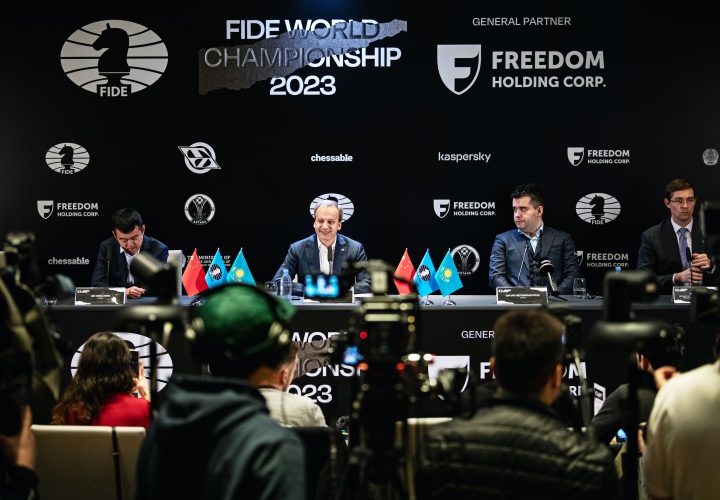
The two contenders for the title of World Champion held their cards close in front of the media, revealing only snippets of intriguing information The first press conference of the 2023 FIDE World Chess Championship Match took place at the Press Centre room of the St Regis Hotel in Astana. The press conference was a momentous occasion as the players and officials gathered to discuss the upcoming match that will determine the 17th world champion in chess. The speakers at the conference were FIDE President Arkady Dvorkovich, Timur Turlov, Founder and CEO of Freedom Holding Corporation, General Partner of the FIDE World Championship as well as the two players – Grandmasters Ian Nepomniachtchi and Ding Liren. Parallels with the 1948 World Chess Championship The first to address the press was FIDE President Arkady Dvorkovich who said that this match represents “the flagship competition for the whole chess world and FIDE.” Drawing parallels with the 1948 World Chess Championship, FIDE President Arkady Dvorkovich highlighted the significance of this year’s event. “Back in 1948, after Alexander Alekhine passed away, FIDE decided to organise a tournament between six players to determine the new World Champion. The players who were due to take part were Max Euwe, Mikhail Botvinnik, Paul Keres, Salo Flohr, Samuel Reshevsky and Reuben Fine. Unfortunately, Fine decided just a few days before the match to pull out, and there was no time for a substitute, so it was a round-robin tournament between five players. Two games were played in the Hague, three in Moscow and the Match was won by Botvinnik.” Dvorkovich was referring to the fact that the current World Champion Magnus Carlsen opted to give up his crown so that this match has to have a different form, to be a duel between two challengers. “You can draw some parallels between 1948 and now, but all parallels are artificial”, the President of FIDE said. From Argentina to Astana – how the host city was chosen Dvorkovich also spoke about the way Astana was chosen to host the match. “The match was supposed to take place in Argentina as they were the main bidder. We then received a very serious bid from Kazakhstan, and we decided to host it here. We are very grateful to them for hosting us… Also, it is more convenient for spectators both in China and Russia to watch the match in a country which is in between, just because of the time zones. Finally, for Kazakhstan itself, this event will create a great impetus for chess”, Dvorkovich said. Honour and opportunity: Why Kazakhstan decided to host the match Timur Turlov, Founder and CEO of Freedom Holding Corporation, which is the General Partner of the FIDE World Championship, noted that the decision to host the Match in Kazakhstan was “simple”, given the ambitions his country has both in chess and globally. “We have a very strong culture of playing chess [in Kazakhstan]. We have a very strong women’s team, we have a lot of kids, and this kind of sport is growing very fast in popularity. Kazakhstan can benefit much from this unique event. We want to use this opportunity to attract more attention to our country as a sports nation and to inspire more children to take up chess and see the social and professional opportunities in this sport”. In recent years Kazakhstan has increased efforts to promote itself to the world, and chess is one of the paths to that goal. Kazakhstan has hosted huge chess events, including the first leg of the Women’s Grand Prix as well as the World Rapid and Blitz Chess Championships. This is the first time the country is hosting a match for the title of world champion. “Hosting this event is a huge honour for us. It’s a chance for many of our chess players and professionals to touch the chess legends, see them in person here, in our capital, to experience the spirit of this great event. As a nation, we can show a high level of hospitality and we hope to continue hosting the best chess events in the world, to continue to promote our country,” Turlov said. The players speak It was time to turn to the players to speak. Despite efforts of the press, they kept their responses mostly short. Asked about how important is it to have the experience of playing one championship match already, Nepomniachtchi responded briefly: “It’s important, but it’s not everything, so I wouldn’t overestimate that”. When quizzed on what changes he made in his strategy in comparison to the Match in Dubai in 2021, Nepomniachtchi was again very brief: “It’s too early to reveal”. Nepomniachtchi, however, did confirm that his team of seconds has been strengthened with new members and that he hopes it will provide him with some novelties in the match. “I hope my skills have improved somewhat. As to my team preparation, I’d prefer not to expose anything. Some of the members of the team have been with me for a long time, but I have some new team members, so I hope my preparation has improved.” World No. 3 Ding Liren was asked to comment on the responsibility this match has put on him in light of the chance of becoming the first Chinese player in history to become a World Champion. “Sometimes I think about becoming the first Chinese world champion as well as the 17th World Champion and writing my name in history. If I can do that, it will be a huge glory”. Ding also noted that many people in China started to follow chess because of the match. He confessed that the decision of Magnus Carlsen not to play in the match – which ultimately meant that he would be the one taking part as a runner-up from the Candidates – surprised him. “I was surprised. Magnus not playing has surprised me a little bit.” Ding was also asked about the support he has from the Chinese government. “The
FIDE World Championship Match 2023 officially opened
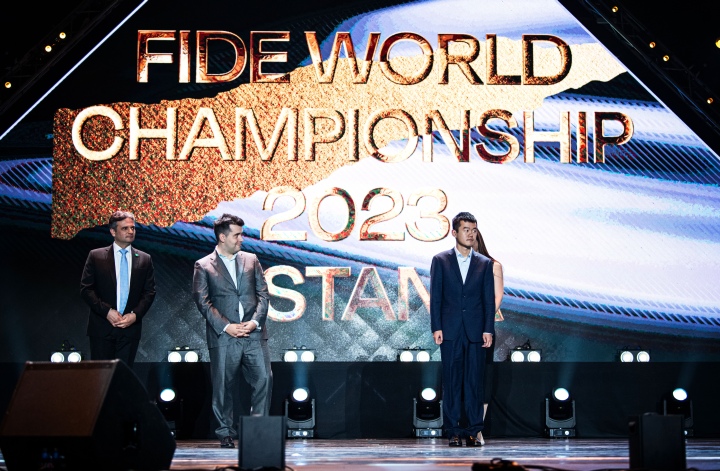
Featuring ballet and Artificial Intelligence, the grand opening ceremony in Astana was a perfect blend of tradition and innovation, setting the stage for a battle to crown the next world chess champion. The 2023 FIDE World Championship Match is officially underway in Astana following a show where music, art, tradition, magic and technology came together to announce the beginning of a three-week event which will grip the chess world. The Astana Ballet Theatre hosted the ceremony, which was attended by the players, Kazakhstan’s Minister of Sports, FIDE President Arkady Dvorkovich, and other high-ranking officials and guests. The ceremony began with a performance by the Astana Ballet Orchestra, which played the well-known composition “One Night in Bangkok” from the musical “Chess”. This was followed by a short video recapping the history of world championship matches. The Minister of Culture and Sports of the Republic of Kazakhstan, Askhat Oralov, took the stage as the first speaker and emphasized the match’s importance for promoting Kazakhstan as a nation that supports all sports. Oralov reiterated Kazakhstan’s commitment to the development of chess at all levels. In a letter addressed to the players and audience, the President of Kazakhstan, Kassym-Jomart Tokayev, echoed Oralov’s sentiment and highlighted that chess is taught in approximately 700 schools across the country. “This outstanding competition held in the heart of Astana will give a big boost to chess development in our country,” Tokayev declared. The speeches were followed by the performance of the Kazakh national anthem – My Kazakhstan. Following on the traditional notes, the audience was treated to the traditional Asem Konyr dance – a dedication to the women of the Great Steppe. As FIDE President Arkady Dvorkovich approached the stage, a woman dressed in traditional Kazakh attire appeared beside him, cradling the coveted trophy that would be awarded to the match winner. “This is the beautiful prize that the two best players will fight for to become the next world chess champion. For both of them, this is an event they’ve been waiting for all their lives. It’s going to be very competitive. They’ll give all the talent and the skills to win it. I am confident that millions of spectators all around the world will enjoy this event, but through it, will also discover how chess makes people fight for something important. I hope that this event will give motivation for millions of kids to play chess, to use chess as a tool to improve themselves, to be better people and to make the world a better place.” Timur Turlov, the CEO of Freedom Holding Corp (which is the General Partner of the Match) and also the President of the Kazakhstan Chess Federation noted the importance of the event for the youth of his country. “This Match is a great chance and a great honour for Kazakhstan. We hope this event will inspire many new chess players. I am sure we will have more of our children in future chess events. Our country is full of bright and talented people, and this type of event is important for us”. Following a spectacular performance by members of the Astana Ballet Theatre, Chief Arbiter of the match, Nebojsa Baralic, stepped onto the stage to officiate the ceremony. He was joined by two players, Ian Nepomniachtchi and Ding Liren. A magician suddenly appeared beside them, signalling that the drawing of lots would be nothing short of magical. Ding Liren was particularly intrigued, closely observing the magician’s every move. But as it turned out, it was all just a playful and humorous illusion. Then came the real drawing of lots. Unlike the traditional way of doing this, with the arbiter holding a black and a white pawn in each hand clinched to a fist, this was done with the help of Artificial Intelligence. A robotic pyramid with a chess piece-filled bowl and a robotic arm on top took centre stage. The AI ceremony had two parts. In the first, one of the players had to name a colour – black or white – and if the robotic arm picked up the piece with the same colour, that player moved to the second stage, where the robot then decided if that player would be White or Black in the first round. As he is currently ranked ahead of Ding Liren on the FIDE rating list, Ian Nepomniachtchi was invited to come forward. Nepomniachtchi curiously walked over and said, “white”, and then pressed a button on the computer. Luckily for him, that was the colour the robot chose as well, which meant he moved on to the next stage. Had he guessed it wrong, it would be Ding’s turn. In the next stage, Nepomniachtchi had to press the button again, and the robot was the one to choose the colour of his pieces in game one. While robots may be better than humans in almost everything, in a sign that they’re still not perfect (especially when it comes to the fine sensory skills of hand movement), it took the robot three times to successfully navigate the task. The robotic hand mixed pieces in the bowl but did not pick up any pieces on the first try. Then, on the second – it picked up two pieces – black and white! On the final, third try – it picked up one piece. Nepo was again lucky – the colour of the piece was white! The honour (and the advantage) of the first move in the match went to Ian Nepomniachtchi. The advantage of playing with white pieces is small but counts at the top level. Nepomniachtchi downplayed the advantage by saying: “White is not bad, but black is good as well”. With the event officially opened, and the first move decided, the stage was set for an epic battle of wits between two chess titans. Who will emerge victorious in this high-stakes match? Only time will tell. But one thing was certain – the world is about to witness a display of brilliance and strategy like never before. The first game is set
2023 FIDE World Championship Match: Preview

The eyes of the world turn to Kazakhstan as the Match for the title of World Chess Champion takes centre stage in the capital of the central-Asian country From 9th April to 1st May two players – neither of whom is a defending champion – will meet for a 14-game match to decide who will be the new, 17th World Chess Champion. The upcoming match is a clash of two contenders – Grandmasters Ian Nepomniachtchi from Russia (currently ranked second in the world) and Ding Liren from China (currently ranked third in the world). Following the decision of the reigning World champion Magnus Carlsen to give up his title, the match is played between the winner and the runner-up of the Candidates Tournament, which was held in July 2022 in Madrid, Spain. While Argentina, Mexico, and China showed interest in hosting the FIDE World Chess Championship, Kazakhstan’s capital stood out as the obvious choice given its location and chess legacy, as well as a convenient geographical location for both players. The match will feature a prize fund of 2,000,000 euros. The winner of the match, if decided in the 14 classical games, will receive 60% of the prize fund, while the runner-up will receive the remaining 40%. However, if the match goes into tiebreakers, the winner will get 55% of the prize fund, and the runner-up will receive the remaining 45%. The NASDAQ-listed Freedom Holding Corp, a US-based corporation that offers financial services and has Kazakh origins, will act as the General Partner of the event. Ian Nepomniachtchi Ian Nepomniachtchi (32), also called “Nepo” in chess circles, has played once already in a World Championship Match – in December 2021 in Dubai, when he was beaten by Carlsen. However, in the Candidates Tournament in Madrid in June/July 2022, he had a stellar performance, winning the event with a round to spare. With his previous experience in a World Championship match, Nepomniachtchi could be considered the senior player of the two. Despite his loss to Carlsen in Dubai, he exuded confidence and used his experience in later tournaments to raise his level of consistency. An important factor in Nepomniachtchi’s victories has been the stability of his repertoire with the black pieces. However, a big risk for Nepomniachtchi is to be content with his current level of play and not push himself further, which may not be enough to win the World Championship match. Ding Liren On the other hand, Ding Liren (30) was not expected to play in the Candidates Tournament but was brought in as a replacement. His journey to the big match was filled with ups and downs, with a key win in the final round securing second place which, following Carlsen’s decision to abdicate the chess throne, was enough for Ding to qualify for the Match! “Ding’s A game is probably better than Ian’s, but if they’re both not at their best, I would say Ian has much better chances. His low is not that low,” was the assessment of GM Daniil Dubov, one of the official match commentators for FIDE, who was part of Carlsen’s team in the previous World Championship. In spite of being one of the top players in the world for some time now, Ding Liren is less visible publicly and gives very little away in his interviews, as he prefers to stay out of the limelight and be perceived as the underdog. This mindset may work to his advantage in the upcoming match, as he can find his psychological comfort zone and show his best. Their previous clashes Ian Nepomniachtchi and Ding Liren know each other well. In 2009, the Russia vs China chess summit saw the first encounter between the two. Nepomniachtchi won all four games in their match, which consisted of two rapid games and two blitz games. Over the next three years, Nepomniachtchi began to dominate in faster time controls at these summits, winning six games and drawing one in rapid and blitz. Nepomniachtchi’s first classical win against Ding Liren happened in 2016 at the Hainan Danzhou GM event. Ian Nepomniachtchi – Ding Liren 35…Qc8? (only 35… Крg7! offered the chance to continue the battle) 36.Rxa6 Rb8 37. Bf2! White won a piece and three moves later Black resigned 1-0 Ding Liren’s payback was in 2019 at the Cote d’Ivoire rapid event, followed by his first classical win at the Croatia Grand Chess Tour tournament later that same year. Ding Liren – Ian Nepomniachtchi Black’s king is in great danger and Ding launched the final onslaught 27. b4! Rc8 28. bxc5 Rxe1 29. Rxe1 hxg3 30. hxg3 dxc5 31. Кg2! Qc2 32. Qe3 Rc7 33. Qe6 Лd7 34. d6 Kc8 35. Rh1! 1-0 In 2019, the players competed in a Chess.com speed event, and Nepomniachtchi dominated and won 19-12. Nepomniachtchi also secured an important win against Ding at the 2020 Candidates Tournament, ultimately winning the event, while Ding Liren managed to equalize the score by winning the return game in the last round. Ian Nepomniachtchi – Ding Liren Ding Liren has just played 33… Rc5? but it failed to 34. Qe8+ Kh7 35. Ng1! Rxb6 36.Qxd8 Rxb2 37. Rxb2 Rc1 38.Qh4+! and after White’s trading the queens it is all over for Black 38… Qxh4 39. gxh4 Rd1 40. f3 1-0 Ding Liren – Ian Nepomniachtchi After precise 19. Qg5! Ding captured Black’s trapped knight – 20..Nxf3+ 20. gxf3 Qh3 21. Bf4! Qxf3 22. Nd2 f6 23. Qxg6+ hxg6 24. Nxf3 – and converted his extra material in the endgame 1-0 At the last Candidates Tournament in Madrid, held in 2022, Nepomniachtchi won the very first round with Black, setting the course of the event. Ding Liren – Ian Nepomniachtchi Ignoring the threat to his b7-pawn Ian launched a dangerous attack – 25…g5! 26.Nxb7? gxh4 27.Nc5 h3 28.Rxe4 hxg2 29.Rxe8+ Kg7 30.f4 – and eventually got to the White’s king 30…Qh1+31.Kf2 Qxa1 32.Kxg2 Bh3+ 0-1 The second game was drawn as Nepomniachtchi executed a drawing line with the white pieces. On the other hand, Ding has shown that he is persistent and that, even if things go terribly wrong,
Nils Grandelius wins Reykjavik Open 2023

GM Nils Grandelius emerged as the winner of the 2023 Reykjavik Open. A tournament regular, the Swedish GM won this event on his 11th attempt! The 9-round Swiss tournament supported by the FIDE Aid Package took place from 29 March to 4 April 2023 in the capital of Iceland. With many strong GMs participating, it was a very close competition that came down to the wire. Suffice it to say that only after Round 5 there was the sole leader in the event – Abhijeet Gupta of India, who scored 5/5. Coming into the final round, as many as five players shared the first place on 6.5/8, but only Grandelius pulled out a so-much-needed victory over IM Quentin Loiseau to finish clear first as all other leaders drew their games. A large group of participants tied for second place, with GMs Mustafa Yilmaz and Abhijeet Gupta taking second and third prizes, respectively, thanks to superior Buchholz. Final standings: 1 Nils Grandelius SWE 2658 7½ €5,000 2 Mustafa Yilmaz TUR 2629 7 €1,414 3 Abhijeet Gupta IND 2620 7 €1,039 4 Maxime Lagarde FRA 2581 7 €814 5 Gabor Papp HUN 2544 7 €714 6 Matthieu Cornette FRA 2563 7 €639 7 Tamas Banusz HUN 2616 7 €589 8 Leon Livaic CRO 2569 7 €589 9 Vasyl Ivanchuk UKR 2664 6½ €350 10 V Pranav IND 2545 6½ €350 The prizes were also awarded in the following categories: 0-2000, 2001-2200, 2201-2400, Seniors 65+, Juniors U16 and Women (pictured below). L-R: WGM Sarah Papp (2), IM Irene Kharisma Sukandar (1) and Nisha Mohota (3) The top eight finishers of the Reykjavik Open 2023 earned FIDE Circuit race points based on the final standings: 1 Nils Grandelius 13,03 2 Mustafa Yilmaz 8,47 3 Abhijeet Gupta 7,82 4 Maxime Lagarde 7,16 5 Gabor Papp 6,51 6 Matthieu Cornette 5,86 7 Tamas Banusz 5,21 8 Leon Livaic 4,56 The following norms were completed at the tournament. GM norm – Sidhant Mohaptra IM norm – Sahithi Varshini and Patryk Cieslak Photo: Hallfríður Sigurðardóttir and official website Official website: reykjavikopen.com/
Aleksandra Goryachkina wins in New Delhi on tiebreaks
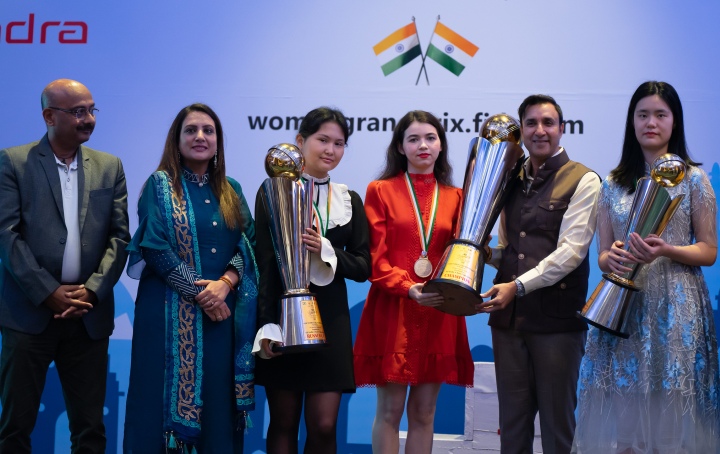
The top three contenders for first place in the third leg of the Women’s Grand Prix all drew their final round games, finishing on six points. After tiebreaks, Aleksandra Goryachkina was awarded first place, Bibisara Assaubayeva is second and Zhu Jiner third The final, eleventh round of the third leg of the Women’s Grand Prix cycle ended with all three tournament leaders drawing their games and finishing on six points. Aleksandra Goryachkina was awarded first place for having better tiebreaks. As per tournament regulations, all prize money and WGP points were divided equally among the players with an equal final score. This means that Goryahckina, Assaubayeva and Zhu all got 12,333 euros and 133 points each. How the final round unfolded The first one to finish, after around two hours and 45 minutes of play, was China’s Zhu Jiner. Playing as Black against Nino Batsiashvili, the position was even and after forced exchanges of heavy pieces, the two agreed to split a point. With this draw, Zhu reached her third GM norm (having collected the first two in the previous two tournaments of the Women’s Grand Prix – in Astana and Munich). China and the world now have a new Grandmaster – Zhu Jiner. Just a few minutes after Zhu, Aleksandra Goryachkina – the other of the three favourites – drew as White with India’s top player and world number two, Humpy Koneru. In the Queen’s gambit accepted, both sides played precisely. It was a balanced game, ending in an even position. Some 15 minutes later, Bibisara Assaubayeva (one of the three leaders) agreed to split a point with Kateryna Lagno. In the Reverse Benoni, Assaubayeva had slightly more initiative, but it was overall even. With this tournament in New Delhi, Bibisara Assaubayeva also achieved her second Grandmaster norm. After more than five hours of play, Polina Shuvalova beat Harika Dronavalli in the Ruy Lopez, while Vaishali Rameshbabu lost a drawn-rook endgame to Nana Dzagnidze. The final standings of the third leg of the Women’s Grand Prix in New Delhi: Player Place WGP points Prize (€) Goryachkina Aleksandra 1-3 133 12,333 Assaubayeva Bibisara 1-3 133 12,333 Zhu Jiner 1-3 133 12,333 Lagno Kateryna 4-5 85 7,375 Shuvalova Polina 4-5 85 7,375 Koneru Humpy 6 70 5,750 Batsiashvili Nino 7-9 50 4,500 Dronavali Harika 7-9 50 4,500 Dzagnidze Nana 7-9 50 4,500 Vaishali R 10 30 3,500 TOTAL 820 74,500 The overall standings in the Women’s Grand Prix 2022/2023 series With a total of 308 points, China’s Zhu Jiner is currently in the lead in the overall standings of the Women’s Grand Prix. She is followed by Aleksandra Goryachkina, who is on 263 points, while Alexandra Koteniuk (who skipped New Delhi) is in third place on 250, closely followed by Kateryna Lagno, who is on 245 points. Zhu’s lead is, however, only symbolic. New Delhi was her third and final appearance in this edition of the WGP cycle. (In the previous events, she secured a third-place finish in Astana, earning 110 points, and fetched another 65 points in Munich.) She will be overtaken after the next and final leg of the Women’s Grand Prix, where top favourites such as Goryachkina, Kosteniuk and Lagno will take part. Still, New Delhi will be a memorable tournament for Zhu as in this event she has also secured her third Grandmaster norm. With this victory in New Delhi, Aleksandra Goryachkina now has 263 points and is currently in second place in the overall standings. Goryachkina came in second in the first tournament in Astana (where she collected 130 points), and first place in New Delhi got her additional 133 points. As this was her second tournament in this WGP cycle, Goryachkina is due to play in the fourth and final leg, which will take place in Cyprus in May. This makes her a very strong contender for the winner of the 2022/2023 edition of the Women’s Grand Prix. The event in Delhi was also the second tournament in the WGP cycle for Bibisara Assaubayeva. Having collected just 30 points in Astana in the first tournament, second place in New Delhi and 133 points boosted her place in the overall standings, as well as her chances to reach one of the top places in this edition of the WGP. The tournament in New Delhi was the third in a series of four which make up the Women’s Grand Prix (WGP). Altogether 16 players are taking part in the series, with each participating in three of the four tournaments. The two players who score the greatest number of cumulative points in the series shall qualify for the FIDE Women Candidates Tournament 2023-24. The next and final event in the Women’s Grand Prix cycle will be held in Cyprus between the 15th and 28th of May. Round 11 Games Recap Bibisara Assaubayeva – Kateryna Lagno Kateryna Lagno is the more senior player of the two – both in experience and titles won but also in the overall score: the two have played 25 games – and Lagno leads 12:4. Once again, in a game where Bibisara was playing with white pieces, we saw the Reverse Benoni. Both sides fought for control of the dark squares in the centre. On move 11 Lagno deviated from the book theory and introduced a novelty 11…Rb8 and reached equality. However, instead of slow manoeuvring Kateryna came up with an interesting pawn push 17…b5, sacrificing a pawn for control over the d5-square. Bibisara opted for a reserved 18.b3, but chess engines suggest that 18.d5! exd5 19.cxb5 is much more unpleasant for Black. As played, White emerged slightly better thanks to some space advantage, but with just a single weakness in her camp Lagno had no problem holding her ground. Soon the two went for a threefold repetition. With this draw, Bibisara finished the tournament with six points and shared first place. Vaishali Rameshbabu – Nana Dzagnidze Out of the six games the two have played, Nana has won four and Vaishali two. In a rare variation
Inspiring Facts about Scholastic Chess
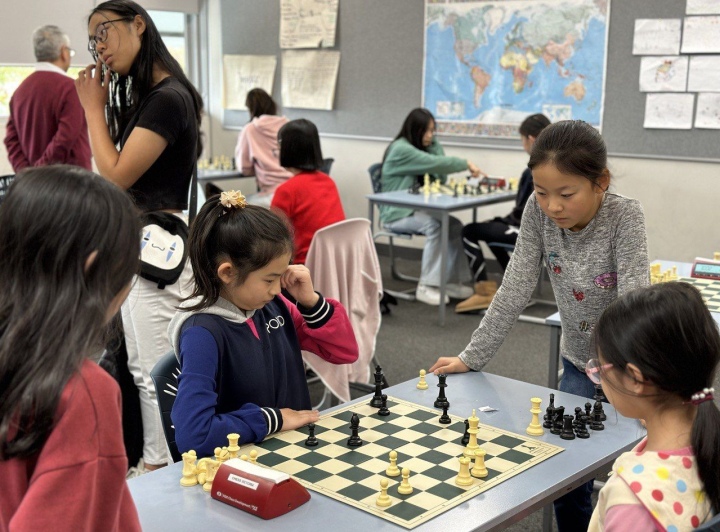
Schoolchildren playing chess at Glen Waverley Secondary College, Australia Do you know which country has integrated chess into its primary school curriculum with huge success? Or can you guess how many underprivileged children in New York City have been taught chess since 1986? And which famous chess player designed an educational program for China? Read on to discover more! While chess has been popular for centuries, it has become much more than just a game, with its potential applied in various fields. Moreover, chess is a powerful educational tool that can help students develop critical thinking, problem-solving, and decision-making skills. Therefore, many countries worldwide have been successfully promoting chess in schools. Photo: Hayk Baghdasaryan | PHOTOLURE One of the best examples is Armenia, which has had a mandatory chess education program for second, third, and fourth graders since 2011. This program has been a huge success, with even world champion Magnus Carlsen stating that Armenia’s experience of teaching chess in schools is a great example for the whole world. During the program’s first years, research was conducted into its effectiveness. The results show that teaching chess promotes the development of creativity, intellect, memory, watchfulness, emotional stability, logical thinking, and willed qualities. In the United States, the “Chess in the Schools” association has been promoting chess education since 1986. The program provides chess instruction to students in New York City public schools, with a focus on underserved communities. The program has been a tremendous success, with over half a million students learning the game and improving their academic and life skills, paving the way for their greatest achievements. Photo: chessintheschools.org/ China is another country that has recognized the benefits of chess education. The Chinese Chess Association has been promoting chess in schools since the 1990s. Moreover, in 2018, the best female chess player in history, Judit Polgar, designed an educational program for China. Her innovative educational chess programs, Chess Palace and Chess Playground, have been introduced into Chinese schools to help the younger generation prepare for the challenges of the future. These are just a few examples of the many countries that have embraced chess in schools as a way to promote education and personal development. The benefits of chess education are clear, and more and more schools around the world are starting to recognize them. If you’re interested in joining the scholastic chess community, we encourage you to participate in the FIDE-ISF World School Teams Online Chess Cup 2023. This tournament is a unique opportunity for students to participate in a global tournament and represent their schools on an international stage. The tournament will be held in Swiss format in two categories: Under-15 and Under-18, giving young players of all skill levels a chance to compete and test their abilities against their peers. The qualification tournaments will take place on April 29th and 30th, and the online finals on May 6th and 7th. To learn more, please visit the official website of the event at https://isf.fide.com/.

